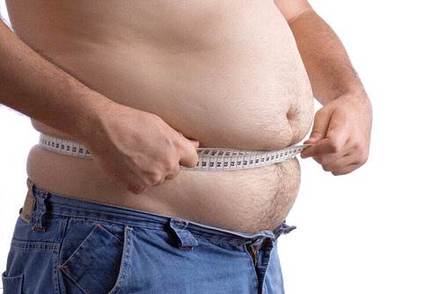|
Do you find it harder to zip up your jeans and feel frustrated of putting on weight? There are more dangers lurking on every corner due to increase in belly fat than preventing you from wearing tight-fitting jeans or other fashionable attire! Fat is fair-it can manifest itself in any place in your body. It can make it impossible for you to squeeze your hands through a sleeveless t-shirt, make it harder to remove your finger ring or push yourself into a pair of your pencil jeans and so on. Figure-conscious individuals are worried over every single bulge or flesh protruding out irrespective of the place where it shows up. But, for physicians and health experts, there is one specific area where fat buildup is extremely dangerous and threatening. Belly Fat Most people associate an expanding waistline with aging which is truer in the case of women whose body fat shifts from hips, arms and legs to the abdomen after menopause. Generally, our body shapes reflect our genes and lifestyle. People accumulate fat in different places and this validates the existence of different body shapes such as pear, apple, hourglass and so on. The two most common ones are apple (weight gets accumulated in the midsection) and pear (bottom-heavy). Men tend to accumulate excess weight on their bellies (might be due to drinking too much beer too :D) while women gain more weight in their legs and bottoms. Post-menopausal women are fatter in the middle section not due to sheer coincidence, but due to decrease in estrogen levels that determine fat distribution in the body. This is also the time during which the risk of heart diseases becomes as profound as a man’s. Nutritionists, dietitians and physicians worldwide link fat around the mid-section with health defects such as heart disease, type 2 diabetes and certain forms of cancer. Weight in any part of your body is not got for health, especially abdominal weight. That’s because, the fat is not limited to the extra layer of padding right beneath your skin (subcutaneous fat) but also includes visceral fat which is located right inside your abdomen and sticking to your internal organs. From the outside, the extra layer of tyres surrounding our belly is the only one visible and the visceral fat lying deep inside is not clearly visible but impacts hard on your health. Impact of visceral fat is more pronounced because too much of this fat can produce substances that can raise blood pressure, impact good and bad cholesterol levels, boost estrogen levels and affect the body’s ability to use insulin. That’s the reason why we quote stroke, cardiovascular disease, type 2 diabetes and other health issues as the consequences of excess belly fat. Diabetes is a dangerous side effect as people lose sensitivity to insulin and the body is pressurized to pump out more. The increase in estrogen levels can elevate the risk of breast and colorectal cancers. There is even research showing that a waist measurement of 35 inches or more in women and 40 inches or more in men are risk factors for the disease. There are even other studies that show that even women with a normal BMI, but a larger waistline have an increased risk of dying of cardiovascular disease, cancer and other causes. Women are Victimized than Men A new study has found that accumulation of central adiposity (belly fat) may be worse for women’s heart health than men’s. Published in the Journal of the American Heart Association, it involved around 5,00,000 people (almost 55% of them were women) aged 40 to 69 years and living in the United Kingdom. Body measurements of these participants were taken and they were followed-up for a period of seven years. During this period, the study group tracked those individuals who suffered from heart attacks and found that, women who carried more weight around the middle were almost 10-20% at an increased risk of heart attack than women who were heavier all around. Weight around the middle was calculated using waist-to-hip ratio, waist-to-height ratio and waist circumference) and total body heaviness was measured using body mass index (BMI). The research also showed that:
 Measure Your Waist Circumference Accurately to Know Where You Stand Measure Your Waist Circumference Accurately to Know Where You Stand Measure Up! Slim or fat, low or high BMI, get your waist measured to see where you stand. BMI or waist-hip ratio can be useful, but your waist measurement indicates your belly fat to the dot! Measure your waist circumference with these steps: Step 1: Placing the measuring tape at the right location is crucial while measuring waist circumference. Place it around your bare stomach just above your hipbone, almost to the level of your naval. Step 2: Adjust the tape such that it fits snuggly around you without hurting your skin and ensure that the tape measure is level all the way around Step 3: Please don’t push in your stomach while taking measurements. Relax, exhale and perform the procedure. What we need is an accurate measure and not some measurement to prove anything to anybody Step 4: Waist circumference of 35 and above for females and 40 and above for males is an indication of pure trouble. Start exercising, follow a healthy diet and stay active to get lost of your belly fat. For any help, get in touch with an RDN at www.firsteatright.com who can help you with the right kind of diet and exercise charts to lose belly fat. Trim Down Given here are few simple ways to bring down your waistline numbers and stay fit: Maintain a healthy body weight: Every individual’s main aim must be to maintain a healthy body weight. Women are challenged after menopause as they pile upon extra kilograms despite the fact that they eat the same quantity and move around as before. That’s due to drastic hormonal changes, a decline in muscle mass (fat burns less calories than muscles) and lifestyle changes. It’s better that women close to their menopause age get their weights and waists measured and introduce small changes to daily routine that help them stave off the extra kilograms from piling up. Any RDN would recommend any individual that gradual weight loss stays for a long time than rapid weight loss that can slow down metabolism and pile up weights quickly. Move more: Regular exercising is critical for a healthy body weight and daily physical activity is recommended to keep your waistline in check. There is no mandatory rule that asks you to hit the gym to lose weight. Squeeze in activity whenever and wherever possible. For example, it might be a walk around your office after lunch or before you get into the car at the end of the day. It is advisable to workout at least for 150 minutes every week to stay fit. Try moderate activities such as brisk walking, hiking, gardening and bicycling and vigorous physical activities such as running, jogging, swimming or fast walking. Daily activity without diet changes may not help you lose weight but it helps you maintain a healthy body weight and improve blood sugar levels in people with diabetes. Mind your food: ‘Beer belly’ is a universal term and alcohol is most-often associated with an increased waistline. Avoid alcohol and other sweetened beverages as much as possible to prevent piling up belly fat. Eat more plant-based foods such as fruits, vegetables and whole grains. Substitute saturated fats with monounsaturated and polyunsaturated fats. Mainly, reduce portion sizes and cut back on calories to lose weight. An extra layer in your belly is a wake-up call to lose weight. When you lose weight, your body too prioritizes on losing belly fat and keeps it top in the list. Even if you lose only 5-10% of your body weight, you can be happy that you have reduced the dangerous layer of belly fat by as much as 30%. A flat stomach with toned abs might not be within your reach instantly, but you can be assured of a healthier body. Comments are closed.
|
AVOID FRAUD. EAT SMART.+91 7846 800 800
AuthorDietitian & Nutritionist Dr. Nafeesa Imteyaz. Archives
July 2024
Categories
All
Dr. Nafeesa's Blog @blogspot |
- Home
- Written Testimonials
- Consult
- Clinics
- Blogs
-
Diet & Nutrition
- Diabetes Reversal
- IVF IUI not needed for PCOS PCOD Infertility
-
Medical Nutrition
>
-
Disease & Conditions
>
- Infertility | PCOS
- Diabetes Mellitus
- Cholesterol
- Hypothyroid
- Kidney Problems
- Hypertension
- Cardiovascular Diseases
- Liver Diseases
- Gastro intestinal disorder
- Cancer
- Metabolic Disorders
- Orthopedic Disorders
- Eating Disorders
- Dietary Recall
- Weight Record Filled By Clients
- Online Payment Transaction Details
- Online Clients Weight Check Form
- Our Program Package Service Charges
- Weight Record 2017 Clients
- Measurements sent by Clients
- Terms & Conditions Of Payment
- Thanks. Your Form is Submitted
- Video Testimonials
- Lifestyle & Wellness
- Lifestyle & Wellness Blog
- Allergy & Intolerance
- Weight Loss / Gain
- Weight Loss / Slimming Blog
-
Disease & Conditions
>
- Life Cycle Nutrition >
- Sports Nutrition >
- Integrity in Nutrition
- Knowledge Centre
© COPYRIGHT 2022. ALL RIGHTS RESERVED. FRST HEALTHCARE PVT LTD.
Dr. Nafeesa Imteyaz of First Eat Right clinic, is the Best Dietitian Nutritionist in Bangalore. Best Dietitian Nutritionist in Pune. Best Dietitian Nutritionist in Hyderabad. Best Dietitian Nutritionist in Chennai. Best Dietitian Nutritionist in Mumbai. Best Dietitian Nutritionist in Delhi. Best Dietitian Nutritionist in Kolkata.


